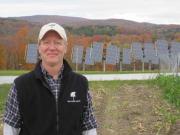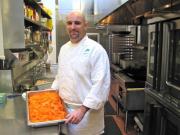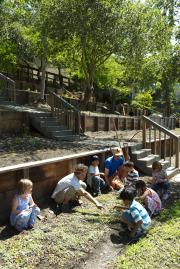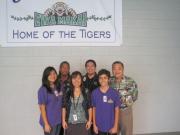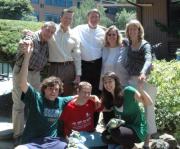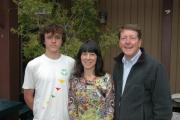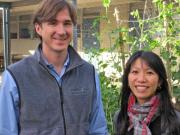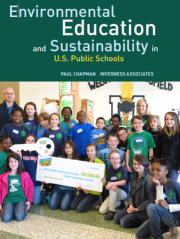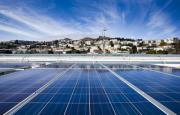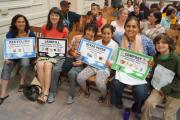San Francisco's Green Schools
San Francisco’s Green Schools: Leading the Environmental Sustainability Movement
Ever since Scott McKenzie’s iconic song in the summer of 1967 urged visitors going to San Francisco to “wear some flowers in your hair,” the city has been associated with a progressive tradition that recently has enabled it to move to the forefront of the environmental sustainability movement in education. Beginning in the 1980s, San Francisco adopted a series of ordinances to promote sustainability, from innovations like curbside recycling and bottle deposits to organic green waste diversion and a ban on plastic bags. The city has taken seriously its goal to eliminate waste. Shortly after the Kyoto Protocol, San Francisco declared its intention to reduce greenhouse gas emissions 20% below 1990 levels by 2020, and in 2004 the city announced its Climate Action Plan. In this culture of environmental innovation, the San Francisco Unified School District, which educates 55,000 students in 120 schools, has developed a model green school program, one distinguished by its comprehensive nature, level of support, and documented accomplishments.
Over the last decade, San Francisco has developed a vigorous commitment to environmental sustainability in education, now called Green the Next Gen, supported by the school district and several city departments, and promoted on the special web site called www.greenthenextgen.org, which is a treasure trove of resources, metrics, programs, and professional development opportunities. The program aims to achieve “the twin goals of promoting student ecoliteracy while reducing the District’s environmental footprint.” Organizationally, the campaign has harnessed the energy of the '4S' Collaborative (SF, Science, Stewardship and Sustainability) to build partnerships between SFUSD and the many Bay Area informal environmental education organizations “to cultivate a dynamic community of ecoliterate students, teachers and families, and to inspire, engage and sustain them in life-long science learning and exploration.” The campaign has launched “major efforts to increase tree plantings at SFUSD sites, install rainwater harvesting cisterns to reduce water use and stormwater runoff, improve energy efficiency, waste diversion, alternative transportation to school, and support green schoolyards.”
The leadership of the San Francisco green schools initiative is vested in about a dozen individuals who are paid professional staff. In 2008 the district hired Director of Sustainability Nik Kaestner to oversee the effort and to focus on sustainable operations, including waste management, energy efficiency, and alternate transportation. A decade ago, the San Francisco Green Schoolyard Alliance was formed, and Director of Programs Rachel Pringle and Executive Director Arden Bucklin-Sporer along with their staff have led a successful effort to turn asphalt playgrounds into natural settings and outdoor classrooms; their organization has just rebranded itself as Education Outside to emphasize that these newly greened schoolyards are places for learning. The district partners with the National Parks Service Golden Gate National Recreation Area (GGNRA) to offer environmental education for students in local parks. Last year the district created a new position to develop the ecoliteracy program in the schools and “to support teachers and school communities in nurturing within students the knowledge, skills, and values essential for them to live sustainably,” and this year the district chose Sarah Delaney to fill this vital leadership role. In addition, the district also maintains an Environmental Science Center in partnership with the National Parks Service at Ft Funston where students engage in hands-on science. All told, there are approximately a dozen paid individuals, and an army of volunteers and allies, helping to lead the SFUSD green campaign. The Director of Sustainability’s position is paid for by the revenue generating departments--the municipal power company and the waste hauling fees in the Environmental Department. The entire Education Outside operation and the Ecoliteracy Content Specialist are foundation funded.
The personal stories of the SFUSD leaders help explain why the district is achieving success in greening its schools. Nik Kaestner recalls that he became interested in environmental issues when his parents moved to the U.S. from Germany and took him to a “substantial number of national parks.” Educated at Stanford, he taught freshman science and AP biology at Palo Alto’s Gunn High School. Appointed the Student Activities Director, he worked to “integrate environmental thinking into the school’s culture,” promoting carpooling, recycling, launching a Green Team that became a model for all of Palo Alto’s schools to follow, and gaining Green Business Certification for the school. He was appointed as San Francisco’s first Director of Sustainability, a position created by the Public Utilities Commission and the Department of the Environment.
Rachel Pringle joined Arden Bucklin-Sporer and San Francisco Green Schoolyard Alliance, now known as Education Outside, as one of its first staff in 2007. Raised on a farm outside Portland, Maine, she recalls fondly growing up in the natural world surrounded by a herd of 60 cattle, horses, and chickens. She received her B.A. in anthropology and M.A. in conservation biology from the University of Pennsylvania in 2001. Heading west she began an internship with the Golden Gate National Parks Conservancy teaching underserved middle school San Francisco students in the nearby Marin Headlands. In 2003 she became a garden coordinator for the Alice Fong Yu Alternative School, and five years ago joined the Alliance to lead their program development efforts. The Green Schoolyard Alliance/Education Outside now has helped transform approximately 90 of the 120 schools in the district. Rachel Pringle credits Berkeley author and landscape architect, Sharon Banks, and her book Asphalt to Ecosystems, with inspiring the green schoolyard movement.
The child of a civil engineer who works for the National Park Service, Sarah Delaney grew up in the Sierra Nevada and Rocky Mountains and remembers that for her family “being in nature was our religion.” As an undergraduate at UC Santa Barbara she won a fellowship to begin teaching underserved youth, and after getting her credential from SF State University she taught science at Aptos Middle School and at the Convent of the Sacred Heart in the city. At the California Academy of Sciences she worked with the Teacher Institute on Science and Sustainability and with the ‘4S” Collaborative to build environmental education partnerships, so it was a natural fit this year for her to accept a position funded by the Bechtel Foundation as the new SFUSD Ecoliteracy Content Specialist to “bridge the gap” between formal and information environmental education and between in-class and outside education. As her job description says, her charge is to build a “fully integrated and aligned Ecoliteracy curriculum that is coherent and consistent across all grade levels and schools.”
Under the leadership of Nik Kaestner and his team, SFUSD has developed an ambitious program to make school operations more efficient and to save energy and money. In an effort to promote savings and accountability, the district posts every school’s operational report card on the Green the Next Gen web site in a Schools Dashboard so that the public can track electricity, natural gas and water usage. The San Francisco Public Utilities Commission provides the data on electricity and water, and using Utility Management Software they measure performance against a baseline figure for each school that is adjusted for temperature variations; Pacific Gas and Electric handles the gas usage. According to the most recent data for the 2011-12 school year, San Francisco efficiency initiatives saved $363,397 from what the district projected it would have otherwise spent. In an effort to achieve further waste reductions, SFUSD has initiated a Shared Savings Plan “to encourage and reward schools that successfully reduce the utility bill at their site.” Schools and administrative buildings receive half the savings they are able to generate, and the funds can be “used to pay for supplies, school programs, or additional efficiency projects” in a discretionary account administered by each school site principal. Since SFUSD gets its electricity from the Hetch Hetchy dam in the Sierras on a highly subsidized rate of 4 cents a kW hour, there has not been a strong push for renewable energy in the public schools.
The Green the Next Gen web site lists each school’s waste diversion rate by month calculated on the basis of trash vs. recycling/compost capacity; school performance ranges from a low of 10% to a high of 90%, with an average rate of 60% of waste that is not sent to the landfill. In an effort to promote transportation efficiency, they have calculated the distance each student lives from school, and have set the following targets: students living less than half a mile should walk, less than two miles should bike, and those over that should carpool or take either a school or public bus. Currently 48% of students in the district do not come in cars; the goal is to move that figure to 75% by 2020. The SFUSD effort to make the schools more environmentally sustainable is multi-faceted. In addition to the district-wide recycling program, the SFUSD has launched the Food to Flowers program to promote site-based composting and to achieve a goal of an 85% diversion rate. A collaborative effort by the Custodial Department and the Department of Public Health has led over half of the school sites to adopt Green Seal certified products.
In 2001 the SF Green Schoolyard Alliance was founded to support the “creation of outdoor learning areas” in the district’s schools and remarkably helped secure almost $14 million in voter-approved bonds to make the vision a reality. Proposition A bonds have or will provide $100,000-$150,000 each to all elementary schools and many middle and high schools in SFUSD. Each school then develops its own master plan and designs and constructs the new outdoor spaces. Green schoolyards are more than just a school garden, and typically include some of these features: native, food-system, vegetable and flower gardens; a green house and composting bins; rainwater cisterns and a pond; solar panels, a sundial and a weather station; student artistic creations like murals, mosaics and paving stones; a labyrinth, accessible paths, and varied habitats; individual, small group and class-size seating areas; and birdhouses or bird feeders, a chicken coop or rabbit hutch. According to Education Outside, a green schoolyard helps students learn “about nature, their local ecology, and are introduced to the values of stewardship” and “can offer children hands-on opportunities to learn about plants and animals (biology), the relationship between the seasons and weather, the sun and the earth (geology/environment), the interrelationships between living things in the garden (ecology), how to grow food and flowers and care for a garden (gardening/horticulture), and how prepare food grown in the garden (cooking/nutrition).” Through its Green Schoolyard Guidelines, Education Outside supports individual schools to find funding for a garden teacher, organize the community to maintain the garden, integrate the green schoolyard into the curriculum, and provide professional development to teachers. With its Outdoor Classroom Initiative, they have launched the Education Outside Corps to develop student environmental stewards and the Schoolyard to Market effort for high school students to sell produce from their school garden at the city’s farmers market. Education Outside “envisions a future in which each schoolyard operates in concert with its neighborhood and local ecology to foster higher academic achievement, increased environmental stewardship, creativity, and community building.”
In 2009 SFUSD created a vision statement for its environmental curriculum, called “Ecoliteracy for All: Every Kid, Every Year, The City as our Classroom.” They adopted a definition of environmental literacy from the UN and argued that all students should experience a program that is place-based, grounded in nature, and enhanced by informal science education organizations. Students should participate in stewardship projects and leadership development. Sarah Delaney’s mission is to make that vision a reality. Already she is working with over 80 Environmental Liaisons in most of the District’s schools to serve as program coordinators, information resources, and advocates. Working with her colleague Lisa Wojcik at the Environmental Science Center, she is bringing the district’s curricular resources to the attention of teaches, like the Urban Trail Blazers program for middle schools, with units on animals, plant, habitats, ecology and human impacts. She also helps to promote a rich array of student programs, after school, through field trips, and community service. Ultimately, she hopes to “capitalize on success” and tell the stories of the district’s “eco-heroes.”
It was good to tour several of San Francisco’s green schools with Sarah Delaney and see the environmental programs in action. Bret Harte Elementary School serves a poor community in the Hunter’s Point district near the city’s Candlestick Park; 95% of the student receive free and reduced lunch, most all are students of color. With a grant provided by Education Outside, Eva Stevens serves as a Green School Corpsmember, running the school’s garden and providing weekly classes to the schools 217 students. Raised in Northern California where she grew up backpacking in the Sierras, she majored in environmental studies and photography at U.C. Santa Cruz, where she developed an environmental “tool kit” that was adopted by the Alliance for Climate Education. It was a delight to observe her teaching an eager group of second and third graders a lesson of pumpkins the day before Halloween. In Noe Valley near the Mission District, we visited Alvarado Elementary School where the greening efforts have been led by principal Robert Broeker and a spirited group of parent volunteers, including Victor Lubet, who is a San Francisco firefighter when not helping at the school to create its beautiful garden. The day of our visit Alvarado “flipped the switch” on a new 50 kW solar array that is estimated to meet 40% of the school’s electricity needs. They have instituted a comprehensive recycling program that diverts 87% of waste and installed a rainwater catchment system. Brooke McClelland serves as the school’s Green School Corpsmember and proudly showed us the extensive garden she has helped to develop. She herself was raised in the South and while a student at Rhodes College in Memphis, she became interested in farmworker’s rights, which eventually led her to the study of organic farming at the Paradise Valley farm in California. She has fashioned a curriculum that introduces students to gardening from A-Z, beginning with the “rules of respect” to the harvest at the end of each 12-week unit. As she said, “we are establishing a garden culture at the school,” and after her two-year assignment, she hopes that the school’s faculty will have fully integrated the garden in the K-5 curriculum.
San Francisco’s public schools are providing a replicable model for the change that is possible throughout our nation’s public education system. With an inspired vision, clear mission, strong leadership, organizational teamwork, and, importantly, adequate funding to support the initiatives, they are demonstrating how we can “grow greener schools.”
